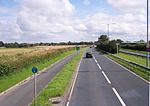St Peter's Church, Formby
18th-century Church of England church buildingsAnglican Diocese of LiverpoolChurch of England church buildings in MerseysideChurches completed in 1873EngvarB from August 2014 ... and 5 more
FormbyGeorgian architecture in EnglandGothic Revival architecture in MerseysideGothic Revival church buildings in EnglandGrade II listed churches in Merseyside

St Peter's Church is in Green Lane, Formby, Sefton, Merseyside, England, and is an active Anglican parish church in the diocese of Liverpool. It was built in 1746 to replace a chapel on another site that had been destroyed in a storm. The church built at this time is in Georgian style. It was extended at the east end in 1873, and this part of the church is in Gothic Revival style. The church is recorded in the National Heritage List for England as a designated Grade II listed building.
Excerpt from the Wikipedia article St Peter's Church, Formby (License: CC BY-SA 3.0, Authors, Images).St Peter's Church, Formby
Green Lane,
Geographical coordinates (GPS) Address External links Nearby Places Show on map
Geographical coordinates (GPS)
| Latitude | Longitude |
|---|---|
| N 53.5664 ° | E -3.0595 ° |
Address
St Peter's Church
Green Lane
L37 7DL , Freshfield
England, United Kingdom
Open on Google Maps







